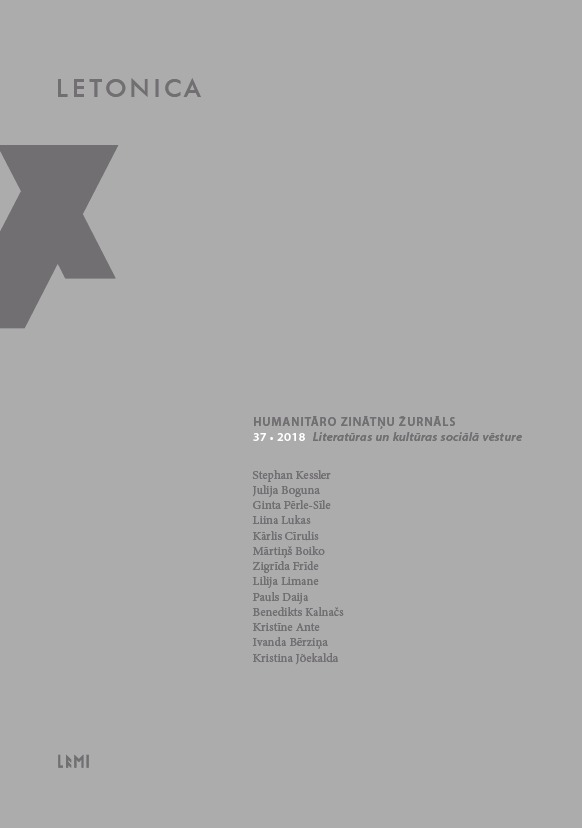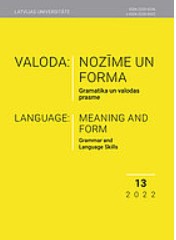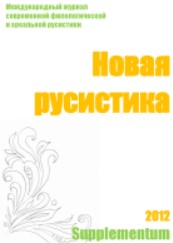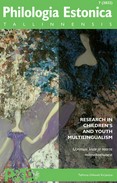Sõnaraamat, mis pakub huvi keelesaarte uurijale
Review of: Sarmīte Balode, Ilga Jansone. Kalnienas izloksnes vārdnīca 1-2. Rīga: LU Latviešu valodas institūts, 2017. 1. kd 648 lk, 2. kd 720 lk.
More...We kindly inform you that, as long as the subject affiliation of our 300.000+ articles is in progress, you might get unsufficient or no results on your third level or second level search. In this case, please broaden your search criteria.
Review of: Sarmīte Balode, Ilga Jansone. Kalnienas izloksnes vārdnīca 1-2. Rīga: LU Latviešu valodas institūts, 2017. 1. kd 648 lk, 2. kd 720 lk.
More...
Although Julius Mägiste in his ”Estnisches etymologisches Wörtebuch” has pointed out the Estonian word family of kasima as well as its Livonian and Votic counterparts as possible Baltic loans, he fails to mention the source word. This article accomplishes the etymology by suggesting *kās- as the possible Baltic etymon, some derived terms being, e.g. Lithuanian kóšti (kóšia, kóšė) ‘to strain a liquid (e.g. milk) for purification, to pass fermented ale through a strainer to prevent sediment from getting into the barrel etc.’ and Latvian kãst, kàst (kāš, kāsa) ‘to strain a liquid for purification, to filter; to drain off the boiled water (e.g. from potatoes) etc.’
More...
There is still no good etymology for the Estonian-Votic terms for malt – Est. linnas, usu. pl linnased, Vot. linnaz, linnahzõt. The etymologies offered this far are based on occasional juxtapositions without sufficient semantic motivation, thus raising more questions than providing answers. The main Finnic brewing terms are Germanic (Scandinavian) loanwords, while Est. õlu ‘beer’ etc. is either of Germanic or Baltic origin. This article considers the possible Baltic (Balto-Slavic) origin of the Estonian-Votic malt name, seeing the donor form in the Balto-Slavic stem variant *linda- (*lindā) ~ *ln̥da- (< I.E. lendh-), some of whose Baltic descendants are Lith. lį̇̃sti (< *lind-ti; leñda, liñdo) ‘to crawl, move slowly, drag (on); germinate, sprout etc.’, Latv. lìst (lìen ~ lìed, lìda) ‘crawl, creep, move slowly; squeeze in; appeal (to), please; cut, mow; sprout, germinate etc.’, OPru. lindan (accsg) ‘valley’, Rus. ляда ’assarted field or grassland; a plot of woods or bush assigned for slash and burn; virgin land; fallow land overgrown with grass or brushwood; low grass; bush, young woodland etc.’, (O)Cz. lado ‘overgrown, fallow, bad land’, Pol. lada ‘virgin land’ etc. (Slav. *lęd-). The presumed meaning of the Baltic (Balto-Slavic) source word is ‘germ, sprout (of a plant or grain)’. The borrowing must have adapted to the nouns with inflectional suffix -kse: *linta- > *linδa-kse-. The above etymological suggestion is supported by some (East) Slavic malt names analogously associated with germination such as Rus. dial. рóща ‘growth force; germ, sprout; greenery; shoot, runner; young mixed forest; germinated barley, malt’, рости́ло ‘rye malt’, BRus. рόшча ‘shoot, plant, germinated grains, growth in length’. Those Slavic malt names have semantic Finnic parallels such as Vot. itü ‘germ; malt’, Fin. dial. itu ‘germ’: itujauhot ‘malt’, Ingr. iDü ‘malt’, Olon. idy ‘germinated grains before drying’ etc., Lud. id́u: id́ud́auhod pl ‘malt flour’, Veps. idu, id́u: idujouh.
More...
Though there is a tendency to overstate the historical and contemporary importance of the Latvian Song Festival for Latvia, to a degree, where it almost seems redundant to talk about the subject, the gravitational field and the multidimensionality of the Song Festival is indeed remarkable, especially the more it is reflected on from a theoretical standpoint. This article is an attempt to give an interdisciplinary overview of the immense gamut of topics revolving around the Song Festival, which could and should be addressed with the help of in-depth research. This cultural phenomenon is a nexus that is comprised of aspects from the history of education and choral singing, society and fraternity building, cultural transfer and localisation, social communication, cultural memory, national ideas and icons reflected onto and derived from it, Aesopian communication forms and many other anthropological, cultural and media phenomena. Even modern infrastructural questions are integral part of the success of this project, for instance, the railroad system and electricity networks. Above all, the Song Festival was a means to create a common national space, with a collective memory and national iconography. Among many other researchers, Jan Assmann’s work in particular shows how fundamental celebrations and rituals are for a collective cultural memory. His theses are enlightening, when applied onto the matter of Latvian Song Festivals, which can be considered an exemplary instance for creation of collective memory through a central cultural event. The article contextualizes Latvian Song Festivals not only within the German tradition of the festival, but also on a more theoretical level, describing it as a part of the nationalization process in Europe and as one of many ritual forms, which are fundamental to a cultural group’s collective memory, identity and nationality.
More...
The aim of this article is to provide a reading of 19th century Latvian literature from the perspective of popular culture. This branch of literature has traditionally remained understudied due to the low creative quality and the prevalence of translations. In earlier investigations the attention has mostly been drawn to historical importance, as opposed to aesthetic features. Similarly, literature usually defined as “elitist” and canonized as classical, has rarely been examined in the context of popular literature. On most occasions it has been dealt with in isolation from other literary trends. Although “elitist literature” cannot be regarded an accurate definition, its application is productive due to the fact that the connection between Latvian literature and national awakening with its concept of Lat vians as a nation of culture is emphasized. This article intends to provide a framework that might be applied to the analysis of the aesthetics of “low” literature, and highlights how this approach can be useful for the understanding of interconnections between popular culture and literature included in the canon of literary history. The introduction of the article examines the significance of popular culture in mid-19th century; the rest is dedicated to the appropriation and re-creation of literary characters borrowed from the mid-19th century popular literature and transferred to 19th and 20th century texts. The authors also discuss the disintegration of borders between the elitist and popular culture as a significant impulse for artistic innovations. These tendencies have been contextualized following two different versions of the story of Genoveva, the 1846 novel Countess Genoveva (Grāfa lielmāte Genoveva) by Ansis Leitāns and the unfinished drama Genoveva by Rūdolfs Blaumanis written in 1908.
More...
The article is dedicated to the twenty-five years of experience gained while teaching Latvian to Finnish students at the University of Helsinki. The introduction to the article gives an insight into the beginnings of the Baltic studies in Finland, the restoration of the lectureship in the 90s of the 20th century, and introduces the current situation. The aims of contemporary students when they choose the Baltic languages as their main study subject are discussed, as well. The article considers the difficulties faced by Finns in learning a new Indo-European language: it briefly explores the difficulties of pronunciation – especially the pronunciation of voiced and voiceless consonants, and the differences in morphological categories (gender and number) in Finnish and Latvian. Word derivation paradigms are the most complex part of speech. Verbs and pronouns are mentioned among the most difficult subjects for students, while the first conjugation verbs (or “short” verbs) and reflexive verbs are the most difficult to learn (not only because of their form, but especially because of their use). All Finnish students (especially those who have not encountered other Indo-European languages) consider prefixation the most challenging of the grammar topics. Latvian language prepositions and their government also cause many mistakes. Naturally, the students translate many sentences literally from their mother tongue. Consequently, for example, there are difficulties with the expression of such concept as future of the verbs or the constructions of Latvian double denial. The article is based on a voluminous material of student errors. It is the analysis of errors that helps the Latvian language lecturer to identify problems and to emphasize and explain the most difficult things in the study process.
More...
This diachronic and contrastive study briefly outlines the trends of the ordering of lexical items in Greek Koine and Latvian, focusing on the four Gospels of the New Testament and four translations thereof into Latvian, spanning the 18th–21st century. The language of the Bible has had a lasting influence on the formation of the Latvian literary language. The word order in Latvian and Greek is relatively free, however, it is possible to note certain trends, to wit, 1) at the level of certain parts of speech where there are words with a fixed position, either postpositives or prepositives; 2) placement of words in Noun Phrases; as well as 3) the ordering of constituents within the clause where the order depends on the information status, i.e., on whether it is presupposed or asserted, and on the presence of particular syntactic constructions. In terms of word order, it appears that the oldest Latvian translation of the Bible is closer to the Koine original, albeit at times it also shows some German influence.
More...
Review of: Igaunu-latviešu värdnlea. Eesti-läti sõnaraamat. Atbildlgais redaktors / Vastutav toimetaja Valts Ernštreits. Sastädltäji / Koostajad Valts Ernštreits, Marika Muzikante, Maima Grlnberga. Riga: Latviešu valodas agentüra, Tallinn: Eesti Keele Sihtasutus, 2015. 1096 lk.
More...
Review of: Läti-eesti sõnaraamat. Latviešu-igaunu värdnica. Projektijuht / Projekta vadltäjs Arvi Tavast. Sõnaraamatu töörühm / Värdnicas darba grupa Merle Madisson, Aive Mandel, Tauno Nõulik, Anita Tannenberg. Eesti Keele Instituut / Igaunu valodas institüts. Tallinn / Tallina: Eesti Keele Sihtasutus / Igaunu valodas fonds, 2015. 737 lk.
More...
Review of: Laimute Balode, Ojārs Bušs. No Abavas līdz Zilupei. Vietvārdu cilmes īsā vārdnīca. Zin. red. S. Rapa. From Abava to Zilupe. The origin of Latvian geographical names. Scientific editor S. Rapa. A short dictionary. Latviešu valodas aģentūra, 2015. 303 lk.
More...
Reviews of: Jean-Pierre Minaudier. Grammatika ülistus. Ühe kirgliku rahvaste- ja sõnadehuvilise lingvistilised rännakud. Tallinn: Varrak, 2017. 149 lk. Liivi rahva keel ja meel. Eduard Vääri uurimused liivlastest ja liivi keelest. Tallinn: Eesti Teaduste Akadeemia Emakeele Selts, 2016. 429 lk. Keiti Vilms. @keitivilms. Eesti esimene säutsukogumik. Tallinn: Tänapäev, 2017. 175 lk. Ajapüüdja. Mälestusi Kokora mailt. Kogunud Andrus Kasemaa. MTÜ Alatskivi Kogukonna Arenguselts, Liivi Muuseum, 2017. 453 lk.
More...
Review of: Kihnu sõnaraamat. Koostanud Reene Leas, Reti Könninge, Silvi Murulauk, Ellen Niit. Toimetanud Karl Pajusalu, Jüri Viikberg. Kihnu Kultuuri Instituut, Eesti Keele Instituut, Tartu Ülikooli eesti ja üldkeeleteaduse instituut. Kihnu– Pärnu–Tallinn–Tartu: Eesti Keele Sihtasutus, 2016. 652 lk.
More...
Review of: Valter Lang. Läänemeresoome tulemised. (Muinasaja teadus 28.) Tartu: Tartu Ülikooli Kirjastus, 2018. 320 lk.
More...
Review of: Benita Laumane. Zvejasrīku nosaukumi Latvijas piekrastē. Liepāja: Liepājas Universitāte, Kurzemes Humanitārais institūts, 2019. 507 lk.
More...
Review of: Dr. Bertram. Balti visandid. Värvikaid lugusid 19. sajandi Eesti- ja Liivimaalt. Saksa keelest tõlkinud, kommentaarid ja järelsõna Pille Toompere. [Püünsi:] Kirjastus Bertram, 2022. 359 lk.
More...
The author of the contribution deals – on the occasion of the approaching 10th anniversary of the takeover in the Czech Committee of Slavists in 2003 as a star-ting point of the institutional crisis in international Slavonic studies – with the International Committee of Slavists and with the forms and methods of its activity. He presents a set of proposals to bring a necessary change concerning the special commissions, the participation of young researchers, the system of management etc.
More...
The study investigated the accuracy of non-word production by bilingual and monolingual children. The participants (125 children in total) belonged to two groups of bilingual children with different language repertoires and one group of monolingual Lithuanians. The analysis revealed that the overall performance of both bilingual groups was better than in the monolingual group. The bilingual children demonstrated more accurate and statistically significant results in repeating longer and structurally more complex non-words. The findings of this study suggest that the bilinguals being acquainted with two phonological systems had a greater experience with diverse phonology, which ensured a more precise performance of the task.
More...